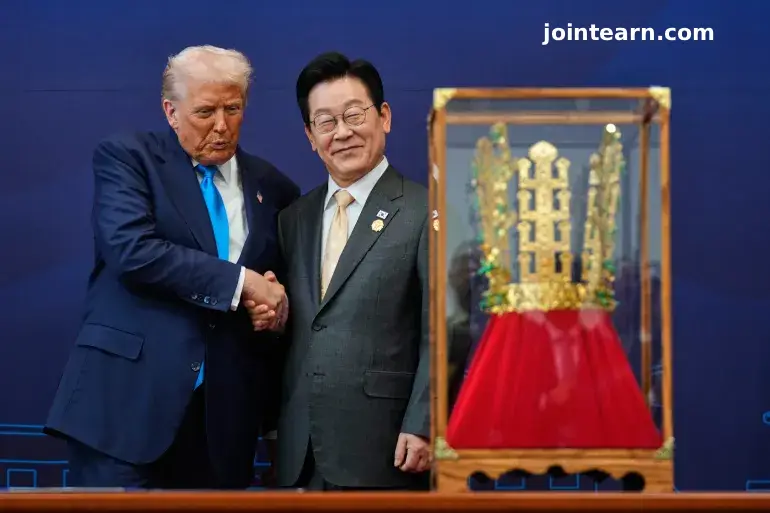
During a ceremonial visit in Seoul, President Donald Trump receives rare honors and lavish gifts as South Korea seeks to finalize a multibillion-dollar trade investment framework.
Seoul, South Korea – October 29, 2025
The United States and South Korea have made progress in ongoing trade negotiations, with discussions centered on $350 billion in South Korean investments into the U.S. economy. The diplomatic overture came during President Donald Trump’s final stop on his Asia tour — a visit marked by grand ceremonies, symbolic gestures, and a series of gifts from South Korean President Lee Jae Myung.
Diplomatic Pageantry and Progress in Trade Talks
President Lee rolled out a warm and elaborate welcome for Trump, presenting him with a gold medal and a replica royal crown during a state ceremony in Seoul. Both leaders hailed the progress made on trade and investment talks, though no final deal has yet been signed.
Trump, speaking alongside Lee, said that the deal was “pretty much finalised,” while Lee’s administration described ongoing cooperation on shipbuilding, manufacturing, and automobile exports as part of the framework agreement.
According to Kim Yong-beom, Lee’s chief of staff for policy, both sides agreed to maintain reciprocal tariffs of 15 percent on automobiles and auto parts — South Korea’s largest exports to the United States. The reduction from a previous 25 percent tariff could significantly benefit automakers Hyundai and Kia, which have struggled to compete with Japanese and European brands facing lower U.S. tariffs.
The White House has yet to formally confirm those details but acknowledged “substantial progress” in discussions.
A Day of Flattery and Ceremony
The South Korean government dialed up the pageantry to appeal to Trump’s well-known appreciation for ceremonial honors. When the U.S. president stepped off Air Force One, a military band played his 2020 campaign anthem, “YMCA,” and a lunch was served featuring U.S.-raised beef and gold-adorned brownies.
During the state meeting, Lee praised Trump, saying, “You are indeed making America great again.” Trump responded with visible enthusiasm, remarking,
“That was some spectacle, and some beautiful scenes. It was so perfect, so flawlessly done.”
Trump, known for valuing symbolic gestures, appeared deeply impressed by a choreographed flag display during the welcoming ceremony. The day’s events, observers noted, highlighted South Korea’s strategic use of flattery to ease trade tensions and strengthen bilateral relations.
The Trade Negotiation Challenges
Despite the cordial atmosphere, major issues remain unresolved. Trump has pressed for $350 billion in direct South Korean investments in the United States — a figure Seoul has hesitated to commit to in full. South Korean officials argue that such a large outflow could destabilize domestic markets, proposing instead a mix of loans, guarantees, and infrastructure partnerships.
“We haven’t yet been able to reach an agreement on the structure of investments and how the profits will be distributed,” said Oh Hyunjoo, South Korea’s deputy national security director.
The cautious pace contrasts sharply with Japan’s more aggressive approach. Tokyo has already pledged $550 billion in investments under a separate trade deal, with U.S. Commerce Secretary Howard Lutnick confirming $490 billion in active commitments at a recent Tokyo business dinner.
Broader Context: The APEC Summit and Regional Diplomacy
Trump’s visit coincides with the Asia-Pacific Economic Cooperation (APEC) summit in the historic South Korean city of Gyeongju, where regional leaders are grappling with economic slowdown, trade tensions, and protectionism.
Lee, addressing the forum before Trump’s arrival, emphasized the need for cooperation amid rising nationalism:
“At a time when protectionism and nationalism are on the rise, words like ‘cooperation’ and ‘inclusive growth’ may sound hollow. Yet in times of crisis, APEC’s role as a platform for solidarity shines brighter.”
The visit followed Trump’s stops in Japan and Malaysia, where he sought to advance trade partnerships and signal that his tariff-heavy strategy is yielding results for American workers — even as the U.S. government shutdown extends into its fifth week.
Shower of Gifts and Symbolism
Among the most striking moments of Trump’s trip was the presentation of the Grand Order of Mugunghwa, South Korea’s highest civilian honor. Trump became the first U.S. president to receive the medal, traditionally reserved for Korean presidents and heads of state.
He was also gifted a replica of a Silla Kingdom gold crown, modeled after the 1,400-year-old artifact discovered in Gyeongju — once the capital of the ancient kingdom.
“It’s as beautiful as it can possibly be,” Trump said. “I’d like to wear it right now.”
The gifts, steeped in historical significance, underscored Seoul’s intent to elevate Trump’s visit beyond mere negotiation — framing it as a celebration of enduring U.S.–Korea friendship.
Points of Strain Beneath the Smiles
Despite the ceremonial warmth, tensions persist. In September, more than 300 South Korean workers were detained during a U.S. immigration raid at a Hyundai plant in Georgia, sparking outrage in Seoul.
President Lee said at the time that such incidents could undermine Korean investment confidence in the U.S.
“Unless the visa system improves, establishing local factories will become very difficult for our companies,” he warned.
Asked about the incident this week, Trump claimed he opposed the deportations and signaled a willingness to reform visa rules for skilled workers, saying it would “make it easier for companies to bring in the best talent.”
Looking Ahead: China and the Regional Trade Outlook
Trump’s next major engagement will be a meeting with Chinese President Xi Jinping on Thursday — a highly anticipated discussion that could influence the trajectory of U.S. trade relations across Asia. Both Washington and Beijing have signaled readiness to ease tariff tensions, particularly over trade in chemical ingredients linked to fentanyl production.
“China is going to be working with me,” Trump told reporters aboard Air Force One. “They’ll be doing what they can do.”
For South Korea, however, the path forward remains delicate — balancing its economic ties with both global powers while managing domestic political sensitivities.
Despite the pomp and the gold, Seoul’s ultimate goal is pragmatic: securing a softer, sustainable trade deal that maintains access to U.S. markets while preserving economic stability at home.


Leave a Reply